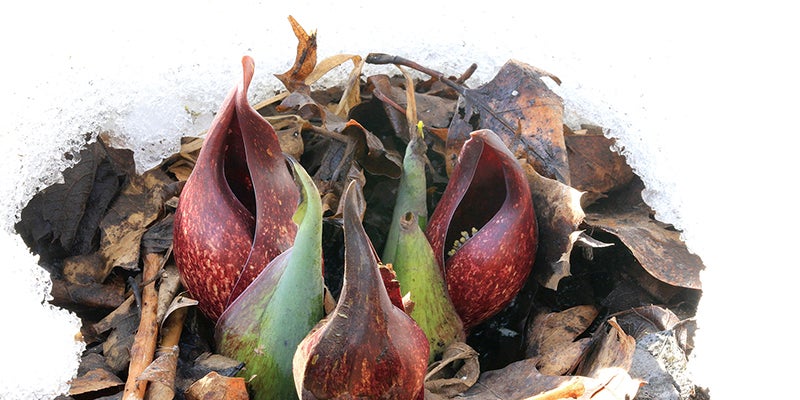Nature Notes: It’s a WHAT cabbage? Skunk
Published 5:16 pm Tuesday, January 25, 2022

- Skunk Cabbage. Photo provided
|
Getting your Trinity Audio player ready...
|
By Kelly Bahl
Outreach Naturalist
Is February too early to look for signs of spring? Not for the eastern skunk cabbage.
While not being a cabbage, nor a skunk, the eastern skunk cabbage has peculiar methods to signal springtime and is one of the first plants to sprout for the year. Skunk cabbage is more closely related to tropical plants like philodendrons and taro (elephant ears) even though it is found in more northern climates. Ranging from the northeastern half of the U.S. and up into eastern Canada, Minnesota, skunk cabbage is found on the western most border of its range. The beginning of February might be a little optimistic for looking for spring, but closer to the end of the month skunk cabbage is right there with us ready for warmer temps and winter to end.
Its common name came simply from the fact that the leaves look like a cabbage. The other half of its namesake is aptly named from the odor it releases. When its leaves get broken or ripped, or when it is in bloom, this plant can emit a pungent smell not unlike the aroma of a spooked skunk. The main reasoning behind producing such a stink is to attract a special pollinator: flies looking for smelly or rotting things to eat! Even with such a defining feature as producing a smell akin to a skunk, its odor is not the star of the show when it comes to tricks up the skunk cabbage’s hypothetical sleeves.
Eastern skunk cabbage is the perennial pioneer of spring. It is a forerunner when it comes to the phrase “spring has sprung” and will sprout when there is still a substantial amount of snow on the ground. The way that this plant can accomplish such a feat is to melt the snow that is above it so it can get much needed sunshine and fresh air. This is an anomaly in the plant world as it is one of the few plants that is capable of thermogenesis (to make its own heat).
Temperatures between 55-95 degrees Fahrenheit can be generated by this plant, which is plenty to melt the snow around, and create a small updraft of warm air to help carry its odor for enticing pollinators. Being able to produce heat will allow for an earlier start to its growing season as it warms up the frozen soil around it to obtain water and nutrients for the roots and to melt the snow above it to get access to sunlight for photosynthesis and making its own food.
When out for a stroll in late February or early March you can look for holes in the snow with cabbage looking leaves or a flower pod that’s reddish purple to black in color very close to the ground. You might even be able to see the warm air coming off of it. These plants prefer wet mucky soil so can be found along stream beds or marsh and bog ecosystems but keeps its ground by focusing all yearly growth under the surface. Every year the roots contract to go a little bit deeper to have a stronger hold each year. Essentially growing downward as opposed to upwards like most plants do.
February at the Nature Center
We are renting cross-country skis and snow shoes as long as there is enough snow on the ground. There are a few paid classes for ski lessons available for registration online. Go to our website at hormelnaturecenter.org/upcoming-programs-and-events for more details.
Ski rental: $6 for adults, $1 for kids
Snowshoe rental: $5 for adults, $1 for kids
Free ski and snowshoe rentals on Fridays 3-6 p.m.
Rental times
Monday-Thursday: 9 a.m. to 5 p.m.
Friday: 9 a.m. to 3 p.m.; (3-6 p.m. free ski)
Saturday: 9 a.m. to 5 p.m.
Sunday: 1-5 p.m.
Upcoming events
Feb. 5: Adult Ski lessons- register online, 8:30 p.m.
Feb. 9: Live Bird Program – free program with one of our resident birds, 4 p.m.
Feb. 19: Free Candle-Lit Ski – equipment rental not included, 5:30 p.m.
Feb. 21: American Red Cross Blood Drive – in Ruby Rupner Auditorium, noon to 6 p.m.


